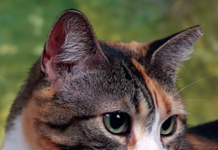From corncobs and newspapers to wood pellets and kenaf, the alternatives to traditional clay kitty litter available on the shelves of pet shops and grocery stores everywhere is astonishing. Sometimes the first one you buy will work for both you and your cat; other times you may have to try several different kinds before you get one your cat will use. And with non-litter-box use being the number one problem for cat owners, we often settle on buying whatever our kitty likes instead of the one we prefer.
But for those of you who want to try something thats made from a renewable resource, or for those daring enough to try something new that may be more environmentally friendly than your current brand, weve put together a brief (and
not necessarily complete) overview of some of the plant-based litters available.
What is kitty litter?
But first a little background. Kitty litter was discovered in 1947 when Ed Lowe of Cassopolis, Michigan, who sold industrial absorbents including an absorbent clay called Fuller’s Earth, was approached by a neighbor who wanted an alternative to ashes for her cat’s box. Lowe suggested she use the clay instead. From then on his neighbor would use nothing else; not only was the clay absorbent, it didnt track like the sand and ashes shed been using.
Lowe thought others would like the cat box filler, so with the help of a local pet store, he gave away bags of clay on which he had written Kitty Litter. Soon people were asking for more and they were willing to pay for it; the Kitty Litter brand became popular nationwide.
Throughout the last 50 years, kitty litter has grown to be a three-quarter-billion dollar per year industry. Today the options include clumping litters that allow urine to form a hard mass that is then scooped out; ones with antibacterial agents that stop the growth of odor-causing bacteria and those with scents that cover up the odor; others that claim to be non-tracking; biodegradable litters that can be flushed; and still others made from paper that are designed to look and feel like clay litter.
The alternatives
If youre interested in using a litter that contains plant-based ingredients such as cedar wood shavings, citrus and various plant fibers from corn, pine, wheat, kenaf, and more, the choices are growing every day. All are available at grocery stores, pet shops, health food stores, and animal feed stores.
Newspaper-based litters include Breeders Choice, EcoFresh, Good Mews, Hi-Tor, and Yesterdays News, made from recycled newspapers. Cats Pride has created Scoop N Flush, a cat litter made from recycled paper that the company says is as safe to flush as bathroom tissue. Wood-based litters include Feline Pine, CareFresh, Cedar Lite, Classic Cat, and Luv My Kitty. Other litters include The Worlds Best Cat Litter (whole kernel corn based), Citra-Fresh (citrus based), Dr. Kenafs Amazing Cat Litter (kenaf based), and SWheat Scoop (wheat based).
One consideration when buying cat litter is how you will dispose of it. Many of the plant-based products can be safely flushed when the box is scooped. They also decompose quickly in compost piles. By contrast, clay litters cannot be safely flushed and must be disposed of with the garbage.
Making the switch
Fred Oehme, DVM, a toxicologist at Kansas State University and editor of the journal, Veterinary and Human Toxicology, likes using alfalfa pellets that come in 50-pound sacks. Its an inexpensive, biodegradable natural product that has a nice odor from the chlorophyll, he reports. When switching litters, Oehme recommends a gradual approach: Mix the old litter with the new, little by little, so your cat has a chance to adapt, he says. Your litter choice should be based on your needs and your cats needs.
So, go ahead and experiment to find the kitty litter that works best for you and your cat. Then all you need to do is keep the box clean!



